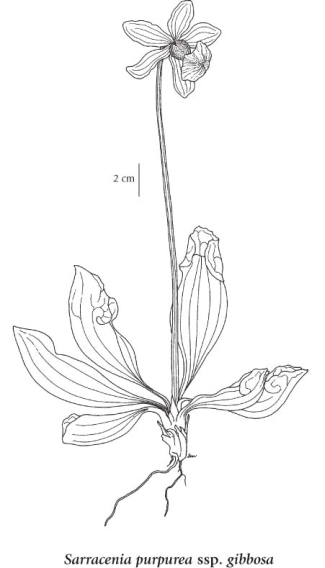Sarracenia purpurea subsp. gibbosa (Raf.) Wherry
common pitcher-plant (purple pitcherplant)
Sarraceniaceae (Pitcher-plant family)
Introduction to Vascular Plants
common pitcher-plant (purple pitcherplant)
Sarraceniaceae (Pitcher-plant family)
Introduction to Vascular Plants
Map
Distribution of Sarracenia purpurea subsp. gibbosa
Click here to view the full interactive map and legend
Introduction
Common pitcher plant is a native carnivorous perennial herb that is found in North America primarily in the eastern United States (Conn., Del., Ga., Ind., Maine, Md., Mass., Mich., Minn., N.H., N.J., N.Y., N.C., Ohio, Pa., R.I., S.C., Vt., Va., W.Va., Wis.) and across Canada (Alta. B.C., Man., N.B., Nfld. and Labr., N.W.T., N.S., Ont., P.E.I., Que., Sask), but is also introduced in California and Washington (Flora North America 2011). In British Columbia, it is restricted in occurrence to the northeastern region of the province, where it is found in bogs and fens in the montane zone (Douglas et al. 2000).
Flora North America provides a detailed discussion and description of pitcher plants in North America. Read more about common pitcher plants in North America by the International Carnivorous Plant Society. |
Species Information
General:
Insectivorous perennial herb from a fibrous root; stems erect, 20-40 cm tall.
Leaves:
Basal leaves clustered, hollow, often marked with purple or dark red, open at the top or with a kidney-shaped flap, with bentback hairs inside the flap and tube.
Flowers:
Inflorescence a solitary flower; petals usually egg-shaped, deep purple on both sides, 2-6 cm long; sepals egg- to diamond-shaped, dark purple outside, pale green inside, 2-6 cm long.
Fruits:
Capsules.
Illustration

If more than one illustration is available for a species (e.g., separate illustrations were provided for two subspecies) then links to the separate images will be provided below. Note that individual subspecies or varietal illustrations are not always available.
Illustration Source: The Illustrated Flora of British Columbia
Habitat and Range
Bogs and fens in the montane zone; rare in NE BC, known only from the Fort Nelson area; N to NT, E to NF and S to NY, VA, OH, IN, IL, MN and CA.Status Information
Synonyms
Synonyms and Alternate Names:
Sarracenia heterophylla Eat.
Sarracenia purpurea subsp. heterophylla (Eat.) Torr.
Sarracenia purpurea subsp. purpurea
Sarracenia purpurea var. ripicola Boivin
Sarracenia purpurea var. stolonifera Macfarlane & D.W. Steckbeck
Sarracenia purpurea var. terrae-novae La Pylaie